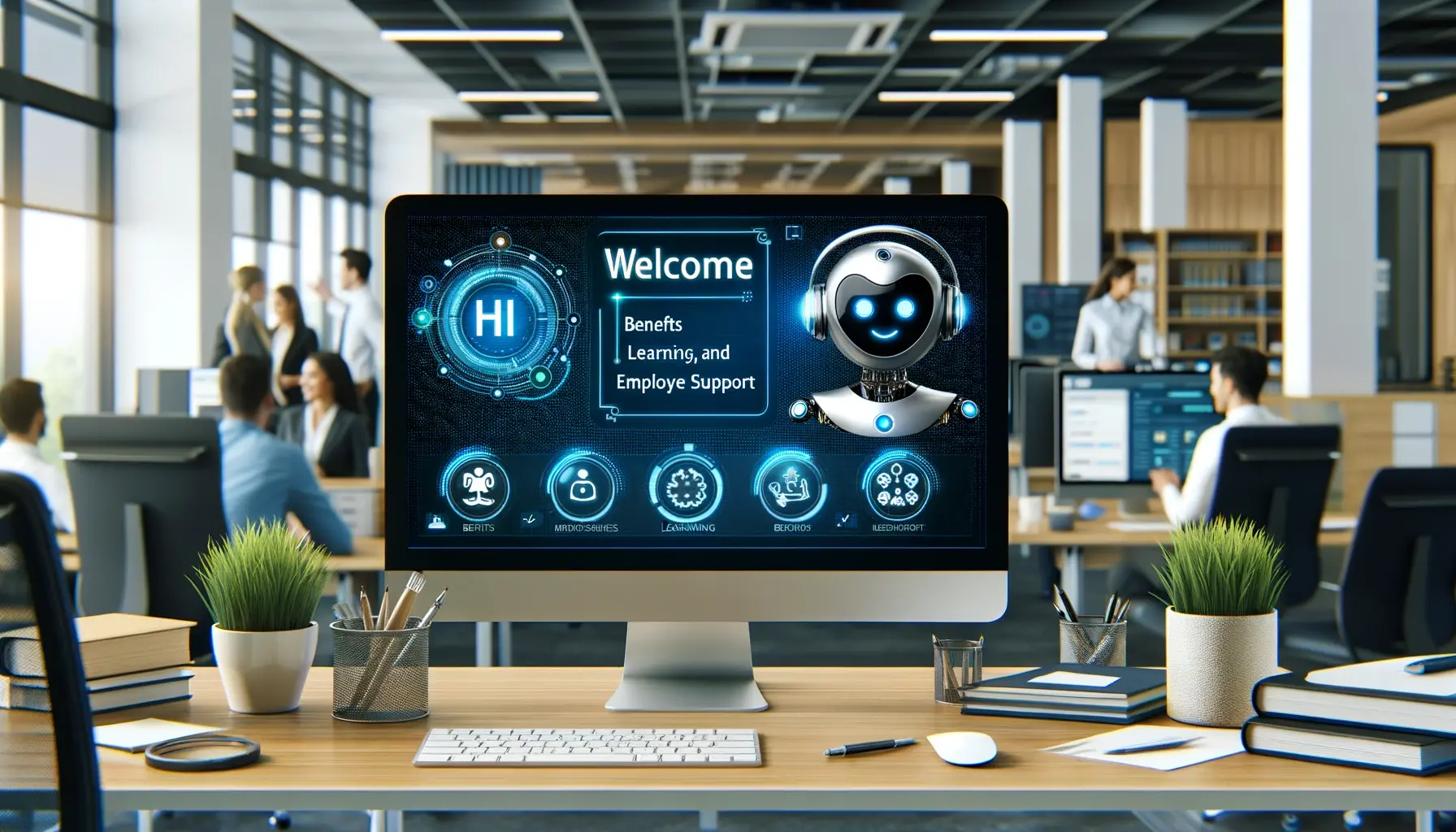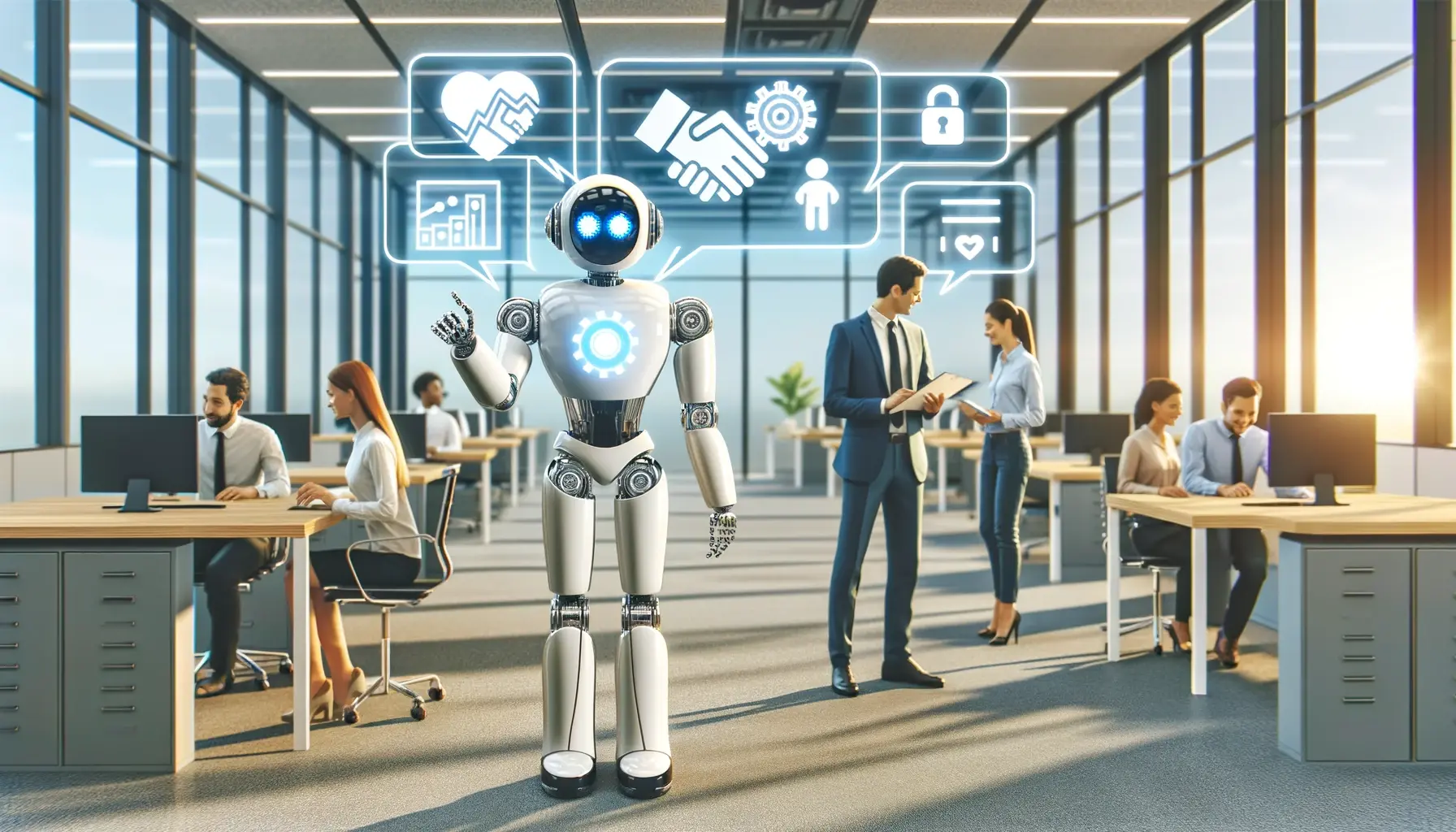Table of Contents
Introduction to HR Chatbots
In the fast-paced world of corporate human resources (HR), the introduction of chatbots powered by artificial intelligence (AI) marks a significant leap forward. HR chatbots are not just tools; they are becoming vital team members, capable of transforming service delivery with efficiency and consistency that is hard to replicate through human efforts alone.
The role of HR within modern organizations has expanded beyond administrative duties, morphing into a dynamic force that shapes organizational culture, drives employee engagement, and fosters talent development. In this context, HR chatbots emerge as powerful allies, pioneering positive change and enabling HR professionals to focus on strategic initiatives by taking on transactional activities.
The Evolution of HR Service Delivery
Traditional HR vs. Modern HR Practices
Traditional HR practices have historically been characterized by manual processes, face-to-face interactions, and paper-based systems. Recruitment involved physical resumes, onboarding required in-person training, and employee queries were handled through direct consultations. These methods, while personal, were time-consuming and often inefficient, with HR professionals bogged down by routine tasks.
In contrast, modern HR practices are marked by digital transformation. Cloud-based HR platforms, online training modules, and digital record-keeping are the new norms. These advancements have streamlined operations, allowing HR to shift from an administrative to a strategic role, focusing on talent management, workforce planning, and employee experience.
The Emergence of AI and Machine Learning in HR
The integration of AI and machine learning into HR represents a further progression from these modern practices. AI algorithms can now parse large volumes of resumes to identify the best candidates, predict employee turnover by analyzing work patterns, and personalize learning and development programs based on employee performance data.
Machine learning systems continually improve their functions by learning from the data they process. This means that the more an HR chatbot interacts with employees, the better it becomes at understanding and addressing their needs. These technologies are not just reactive but can also proactively suggest actions to improve employee satisfaction and productivity.

Benefits of Using HR Chatbots
HR chatbots bring a multitude of benefits to the HR service delivery model:
- Efficiency: HR Chatbots can handle a vast number of queries simultaneously and are available 24/7, reducing response times and increasing overall efficiency.
- Scalability: They can easily scale to meet increased demands without the need for additional human resources, which is particularly useful for growing companies.
- Data Handling: HR Chatbots can quickly process and analyze large datasets, providing HR teams with valuable insights into employee behavior and trends.
- Consistency: They provide consistent answers to employee queries, ensuring that the information distributed across the organization is uniform and up-to-date.
- Personalization: AI chatbots can offer personalized experiences to employees, tailoring conversations and recommendations to individual profiles.
Chatbot 1: The Onboarding Assistant “Ori”
Zenith Innovations has been facing challenges with onboarding remote employees. The HR team needed a solution that could provide a consistent onboarding experience to new hires across different regions and time zones.
The company implemented an Onboarding Assistant chatbot named “Ori,” which was introduced to new hires as their personal guide through the onboarding process. The Onboarding HR chatbots are specialized AI-driven platforms designed to streamline the new hire experience. It’s equipped with a range of features aimed at making the onboarding process as smooth and efficient as possible.
Key features often include:
- Automated Paperwork Processing: The chatbot can guide new employees through the completion of necessary forms, ensuring all documentation is collected and processed efficiently.
- Orientation Scheduling: It can schedule orientation sessions, send calendar invites, and provide reminders to ensure new hires attend essential training.
- Instant Answers: Employees can ask the chatbot questions about company policies, benefits, and job responsibilities, receiving instant, accurate answers.
- Personalized Learning Paths: The chatbot can curate and recommend personalized learning content based on the new hire’s role and learning style.
- Integration with HR Systems: It can integrate with existing HR systems to update employee records in real-time as the onboarding process progresses.
Impact on HR Processes
The impact of an Onboarding HR chatbots on processes can be profound:
- Time Savings: HR teams spend less time on routine onboarding tasks, allowing them to focus on more complex issues that require human judgment.
- Consistency: Every new hire receives the same information and training, ensuring consistency in onboarding.
- Data-Driven Insights: The chatbot can collect data on the onboarding process, providing HR with insights that can be used to further refine and improve the new hire experience.
- Employee Satisfaction: A smooth onboarding process can significantly boost new employee satisfaction and their perception of the company.
- Compliance: By automating compliance-related tasks, the chatbot helps ensure that the company meets all regulatory onboarding requirements.
Chatbot 2: The Wellness Concierge
The Wellness Concierge is a conversational AI designed to assist employees in navigating and utilizing their wellness programs effectively. Its array of functionalities focuses on promoting employee health and well-being. Essential functionalities include:
- Wellness Program Overviews: Provide employees with detailed information about wellness programs, initiatives, and resources available to them.
- Personal Health Tips: Offers personalized health and wellness tips based on the employee’s interests and goals.
- Activity Tracking: Integrates with wearable devices to help track physical activities and provide related insights and encouragement.
- Mental Health Resources: Directs employees to company-provided mental health resources, such as counseling services or stress management workshops.
- Event Notifications: Alerts employees about upcoming wellness events or challenges sponsored by the company.
Example of Implementation and Results
An international corporation implemented the Wellness Concierge to enhance its corporate wellness program. The bot was integrated into the company’s internal messaging system, making it easily accessible to all employees. Six months post-implementation, there was a measurable increase in participation in wellness activities. The company also observed a decrease in short-term sick leave, suggesting an improvement in overall employee health. Additionally, an employee survey indicated a 30% increase in satisfaction with the company’s wellness offerings.
Chatbot 3: The Learning Companion
The Learning Companion is an HR chatbot specifically designed to augment the professional development of employees. With a focus on continuous learning, its core functions are crafted to provide a personalized and interactive learning experience.
Apex Dynamics introduced a live chatbot known as “SkillBot,” specifically designed to facilitate employee learning and professional growth.
The design of the Learning Companion typically includes:
- Skill Assessment: Utilizes AI to assess an employee’s current skill set and identify areas for improvement.
- Learning Path Customization: Offers tailored learning paths based on the skill assessment, ensuring that each employee has a personalized development plan.
- Resource Aggregation: Gathers and recommends various learning resources, such as articles, videos, courses, and webinars, relevant to the employee’s interests and career goals.
- Progress Tracking: Monitors the employee’s progress through their learning paths and provides motivational feedback and reminders to keep them on track.
- Feedback Loop: Collects feedback on the learning materials and experience, allowing for continuous improvement of the learning content provided.
Real-world Application and Feedback
After SkillBot’s integration, Apex Dynamics reported a 40% increase in employee participation in professional development programs. The employees praised the chatbot for its interactive and personalized approach, which made learning more accessible and relevant to their roles. Managers noticed a marked improvement in the team’s performance and adaptability to new financial regulations and technologies.
SkillBot became a cornerstone of Apex Dynamics’ employee development strategy, providing a dynamic and personalized approach to learning that aligned with the company’s commitment to nurturing talent and staying ahead in the financial industry.

Integration Strategies for HR Chatbots
Integrating HR chatbots into existing human resources workflows requires a strategic approach that ensures these tools complement and enhance the efficiency of HR services. The process involves careful planning, execution, and follow-up. Integrating HR chatbots is a transformative process that can significantly benefit an organization if executed with employee-centric strategies.
By following these best practices, addressing potential challenges head-on, and focusing on continuous improvement, HR chatbots can become an invaluable part of HR workflows, leading to higher efficiency and satisfaction.
Best Practices for Integrating Chatbots into HR Workflows
- Understand User Needs: Before integration, it’s crucial to understand the needs of the employees who will be interacting with the chatbot. This can be achieved through surveys, focus groups, and feedback sessions.
- Clear Communication: Clearly communicate the purpose and capabilities of the HR chatbot to the workforce. Employees should know what to expect in terms of the chatbot’s functionality.
- Training: Provide training for both HR staff and employees to familiarize them with the chatbot’s features and best use cases.
Ensuring User Adoption and Continuous Improvement
- Incentivization: Encourage employees to use the chatbot by highlighting its benefits, such as time savings and 24/7 availability.
- Regular Updates: Keep the chatbot’s content and functionalities up to date with regular updates and maintenance, ensuring it continues to meet user needs effectively.
The Future of HR Chatbots
The future of HR is increasingly intertwined with advancements in artificial intelligence, and several emerging trends are set to redefine how HR chatbots contribute to this domain.
- Natural Language Processing (NLP): Enhanced NLP capabilities will enable HR chatbots to understand and interpret human language with greater nuance, making interactions more conversational and natural.
- Predictive Analytics: HR chatbots will increasingly use predictive analytics to inform decisions, such as identifying employees who might be at risk of leaving or who could benefit from specific training programs.
- Greater Personalization: AI developments will allow HR chatbots to offer highly personalized experiences, adjusting communication style and content to the preferences of individual employees.
- Emotional Intelligence: Future HR chatbots may be able to detect and respond to emotional cues, providing support that is empathetic and context-aware, improving employee well-being.
Predictions for the Role of Chatbots in HR
HR chatbots are predicted to take on even more significant roles within HR departments:
- HR Advisors: Chatbots might serve as first-line HR advisors, handling a broader range of inquiries and even mediating in basic conflict resolution scenarios.
- On-Demand Training: They could facilitate on-demand, just-in-time training, and support, becoming an integral part of employee development.
- Talent Acquisition Partners: In recruitment, chatbots may play a pivotal role, engaging with potential candidates and assisting with pre-screening to optimize the talent acquisition process.
- Employee Experience Enhancers: HR chatbots will likely become central to crafting personalized employee experiences, from onboarding to retirement.

Conclusion
The advent of HR chatbots has heralded a new era in human resources management, fundamentally altering the interaction between employees and HR departments.
As we’ve explored throughout this discussion, HR chatbots—through their diverse applications from onboarding assistants to benefits navigators and learning companions—have demonstrated their capacity to streamline operations, personalize employee experiences, and provide actionable insights into workforce management.
Key Takeaways
- Efficiency and Accessibility: HR chatbots offer unparalleled efficiency and are accessible around the clock, significantly reducing the time taken to resolve HR inquiries and allowing employees to access information when they need it.
- Personalization: By leveraging data and machine learning, HR chatbots can deliver personalized interactions, making employees feel understood and valued.
- Future-Readiness: The integration of chatbots prepares organizations for future HR challenges and technological advancements, ensuring they remain agile and responsive to new trends.
The strategic importance of HR chatbots lies in their ability to support and enhance the human elements of HR. Rather than replacing human HR professionals, chatbots provide tools that allow for a more strategic HR function. HR chatbots are becoming a cornerstone of the digital transformation in HR, aligning with broader organizational goals of efficiency, agility, and innovation.
HR chatbots represent a significant leap forward in the evolution of HR service delivery. Their ability to provide immediate, personalized assistance, coupled with their role in facilitating a data-driven HR function, positions them as invaluable assets in the quest for enhanced operational efficiency and employee satisfaction.